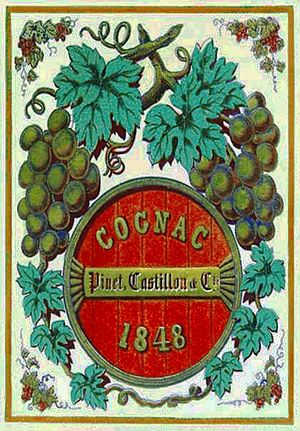Cognac facts for kids
Cognac is a special type of aged grape spirit. It gets its name from the town of Cognac in France. This unique drink is made in the areas around Cognac, specifically in the regions of Charente and Charente-Maritime.
The way Cognac is made is protected by French laws called "Appellation d'origine contrôlée." This means that only spirits made in a certain way and in a specific area can be called Cognac. The main grape used to make it is called Ugni blanc.
To become Cognac, the spirit must be distilled twice in special copper pots. Then, it has to age for at least two years in oak barrels from French forests like Limousin or Tronçais. Many Cognacs are aged much longer than the minimum time. Countries like the United States, Great Britain, and Japan are big buyers of Cognac.
Contents
How Cognac is Made
Cognac starts as a white wine. After it's distilled and aged, it's called eau de vie, which means "water of life." It's made by distilling white wines from specific grape-growing areas.
The Grapes Used
The white wine used for Cognac is very dry and acidic. While it might not be pleasant to drink on its own, it's perfect for the distillation and aging process. Only certain types of grapes are allowed for making this wine.
Fermentation and Distillation
First, the grapes are pressed to get their juice. This juice then ferments for about two to three weeks. During this time, natural yeasts turn the sugar into alcohol. No extra sugar or sulfur is added. After fermentation, the wine has about 7% to 8% alcohol.
Next, the wine is distilled in special copper alembic stills. These stills have a traditional shape and size that is also controlled by law. The wine must be distilled twice. After the second distillation, the spirit, called eau-de-vie, is clear and has about 70% alcohol.
Aging in Oak Barrels
Once the distillation is finished, the clear spirit must be aged in oak barrels from the Limousin region. It needs to stay in these barrels for at least two years before it can be sold. When it's first put into the barrels, it has about 70% alcohol.
As the Cognac ages, it slowly evaporates through the oak barrels and into the air. About three percent of it evaporates each year. This evaporation, sometimes called "the angels' share," causes the alcohol level to drop to about 40% over time. After many years, the Cognac is moved to large glass bottles called bonbonnes for storage. Oak barrels stop adding flavor after about 40 or 50 years, so very long aging might not always improve the taste.
Companies and Brands
There are nearly 200 companies that make Cognac. However, a large amount of the Cognac sold, especially in the US, comes from just four main producers. These are Courvoisier, Hennessy, Martell, and Rémy Martin. Other companies that also make Cognac include Bache-Gabrielsen, Camus, Delamain, and Hine.
Images for kids
See also
 In Spanish: Coñac para niños
In Spanish: Coñac para niños






